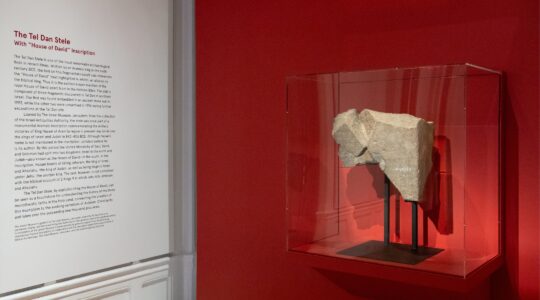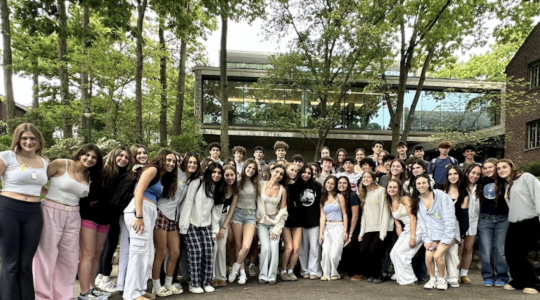On a warm Sunday morning last month in Washington Square Park, parents were leisurely pushing strollers, sunbathers were strewn about on the grass, and people of all ages were lounging on the wooden benches and sipping coffee.
Meanwhile about 15 sixth graders darted around in groups of two or three, their heads bent over iPhones and iPads, shouting out things like, “I just found the foreman. He gave me the money!” “We have to go back to Rose,” and “The shtarkers are after us!”
The kids, students at Stephen Wise Free Synagogue’s religious school, were testing out “Jewish Time Jump: New York.” A mobile GPS “augmented reality” game and interactive story that was launched this week and was just nominated for a Games For Change Award, it is the first such Jewish project of this scope.
Through virtual conversations with historic figures like Rose Schneiderman and Abraham Cahan as well as a cast of fictional characters, “Jewish Time Jump” players — ostensibly reporters for the fictional “Jewish Time Jump Gazette” — race around the park and simulate traveling through time to gather details and perspectives related to early 20th-century Jewish immigration, women’s and labor history.
In a 21st-century twist on the scavenger hunt, players find the requisite clues by physically moving to locations inside and across the street from the park, which is adjacent to the building that once housed the infamous Triangle Shirtwaist Factory. (Today it, like most of the buildings surrounding the park, is part of New York University.) As players move from location to location, archival photos, events and characters appear on their mobile devices, triggered by GPS technology. Students also view historical documents — such as old Yiddish newspaper pages (with translations) and flyers — on their mobile devices as they play.
(Story continues below after Time Jump video here:)
The goal is to spark kids’ interest in and understanding of New York Jewish history.
The game is being released by ConverJent, a nonprofit launched three years ago that “nurtures, develops and spreads ‘seriously fun’ games for Jewish learning,” according to its website. (It is incubated at Clal: The National Jewish Center for Learning and Leadership.)
Rabbi Owen Gottlieb, ConverJent’s founder and director, co-designed and produced the game (game designer Jennifer Ash co-designed it), with a team of 20 and a $65,000 “signature grant” from the Covenant Foundation.
Once regarded as distracting if not downright dangerous, computer games have, in recent years, won new respect in the mainstream education world and, to a lesser but growing extent, the Jewish one.
Rabbi Gottlieb, who is also a Jim Joseph Fellow and doctoral candidate at New York University’s Program in Education and Jewish Studies, is specializing his research on digital media and “games for learning.” He is also currently co-teaching a class in Jewish game design at Temple Israel of the City of New York for post b’nai mitzvah students.
Mobile augmented reality games are a way to “raise subject matter interest and lower barriers to natural curiosity,” he told The Jewish Week, adding, “I want people of all ages to be passionate about Jewish education, and media can help us learn.”
Support the New York Jewish Week
Our nonprofit newsroom depends on readers like you. Make a donation now to support independent Jewish journalism in New York.
Asked why he chose an episode of labor history — the game deals with the New York shirtwaist strike of 1909, also known as the Uprising of the 20,000 — as opposed to another Jewish topic, he said that immigrant history is “already a part of many schools’ curricula” and that he liked how this topic incorporated women’s history and provided “fascinating conflict.”
Available for free at converjent.org, “Jewish Time Jump” is targeted to fifth-to-eighth graders and their families. Rabbi Gottlieb is hoping families and tourists will play it independently and that teachers will incorporate it into their Hebrew school courses.
Harlene Appelman, executive director of the Covenant Foundation, said the grant for “Jewish Time Jump” is part of her foundation’s larger strategy of supporting innovations and technology in Jewish education.
“The excitement and stimulation that digital learning provides is quite astounding,” she said, noting that a few years ago Covenant hosted a workshop on gaming as a Jewish education tool.
The foundation also funded the creation of Aleph Bet app, a free iPhone/iPad app that teaches Hebrew letter recognition to small children, and is supporting a “digital badging” project at a Jewish day school in Atlanta, among other related projects.
Stephen Wise was one of a few local synagogues whose students and parents had the opportunity to preview the game before its launch. In exchange, they offered feedback to help Rabbi Gottlieb and his team refine it and served as subjects in his related research study.
On the Sunday morning they tried it out, the Stephen Wise kids —whose stylish summer clothes and pricey brightly colored Nike sneakers would likely have looked strange to the poor, early 20th-century garment workers they were learning about that day — seemed enthusiastic.
Which was not to say there wasn’t some grumbling: about being rushed (they had only an hour to play the game) and the glare from the sun making it hard to view their screens. Future players will have more time to play; the testers, however, had to spend time filling out paperwork and debriefing, and were also constrained by the religious school schedule.
Overall, however, the game seemed to be a hit
“I think it’s cool that we’re using the technology to learn about this stuff and that it’s for Hebrew school,” said sixth-grader Sam Caplan, who attends “regular school” at Fieldston. “I expect this kind of thing more from a class trip at regular school.”
A classmate named Sophia said, “I thought it was good. I learned more about the conditions and how people were paid. At first I didn’t know what to do, but we figured it out.”
Asked if it was fun, she said, “Yeah. It was more fun that we could be walking around — especially on a nice day, that we could go into the park and interact with each other.”
Support the New York Jewish Week
Our nonprofit newsroom depends on readers like you. Make a donation now to support independent Jewish journalism in New York.
Another student said, “Basically the game was good, but there were some difficulties. When we got ‘attacked’ by the shtarkers [thugs hired by factory bosses to intimidate labor organizers] we didn’t know what we were supposed to do.”
Leigh Rapaport, assistant director of the Stephen Wise religious school, said the kids “really enjoyed being in a different location, being outside and that it was social.”
The activity was also a “perfect fit with our curriculum,” which focuses in sixth grade on American Jewish history, she added.
Because the game runs on ARIS, an open-source platform for playing and designing location-based games that currently works only on iPhones and iPads with 4G, players must have iOS devices (no Androids).
While designed for play on site in Greenwich Village, an off-site version using strategically placed QR codes is in the works.
For more information about “Jewish Time Jump: New York,” go to www.converjent.org.
The New York Jewish Week brings you the stories behind the headlines, keeping you connected to Jewish life in New York. Help sustain the reporting you trust by donating today.




